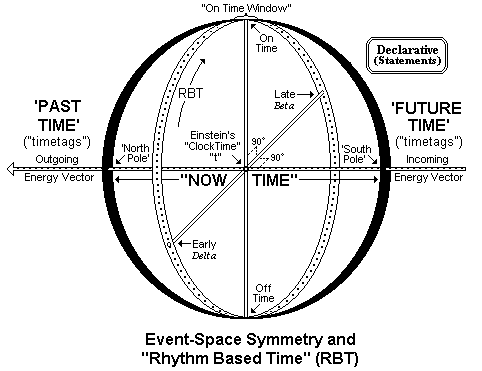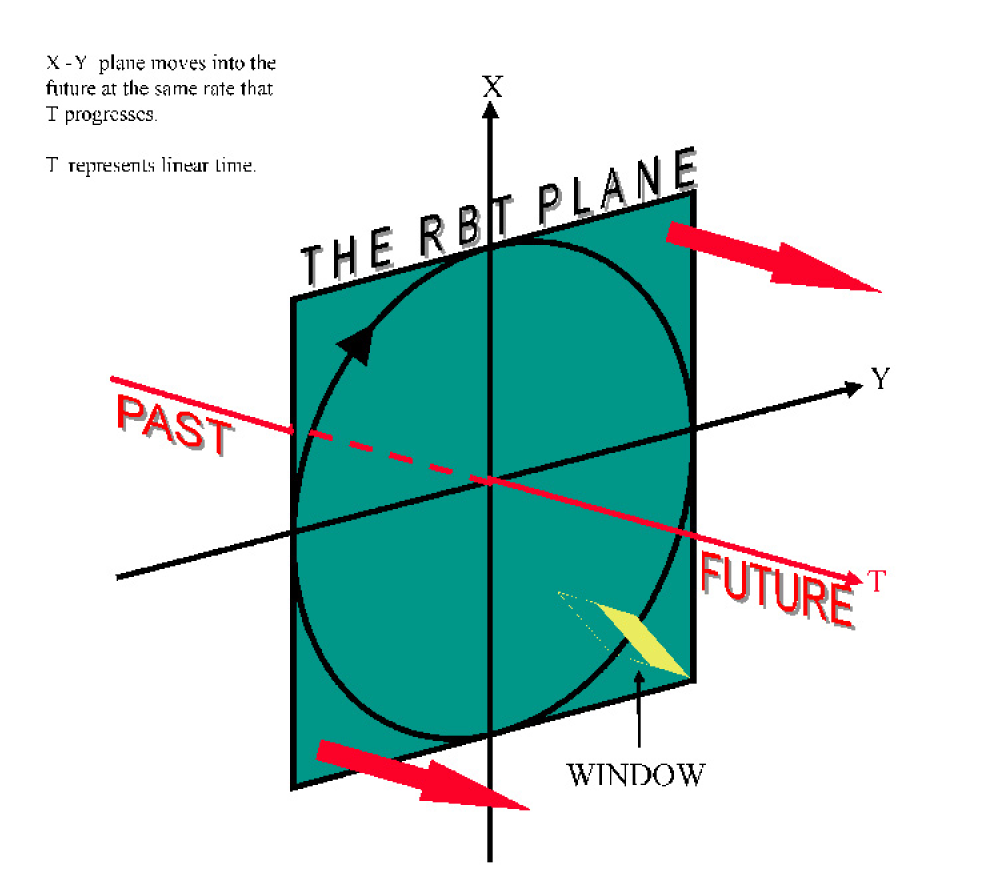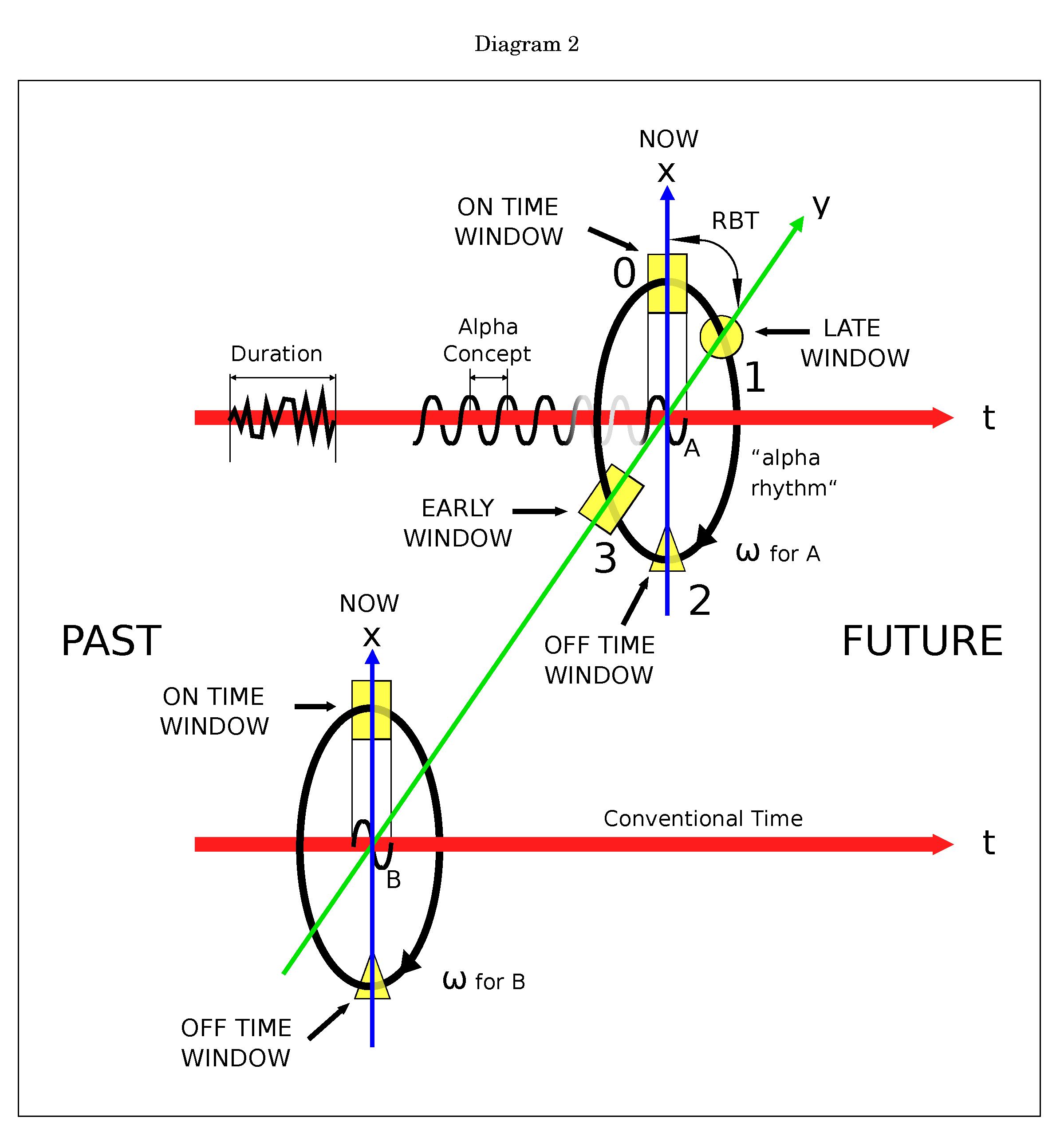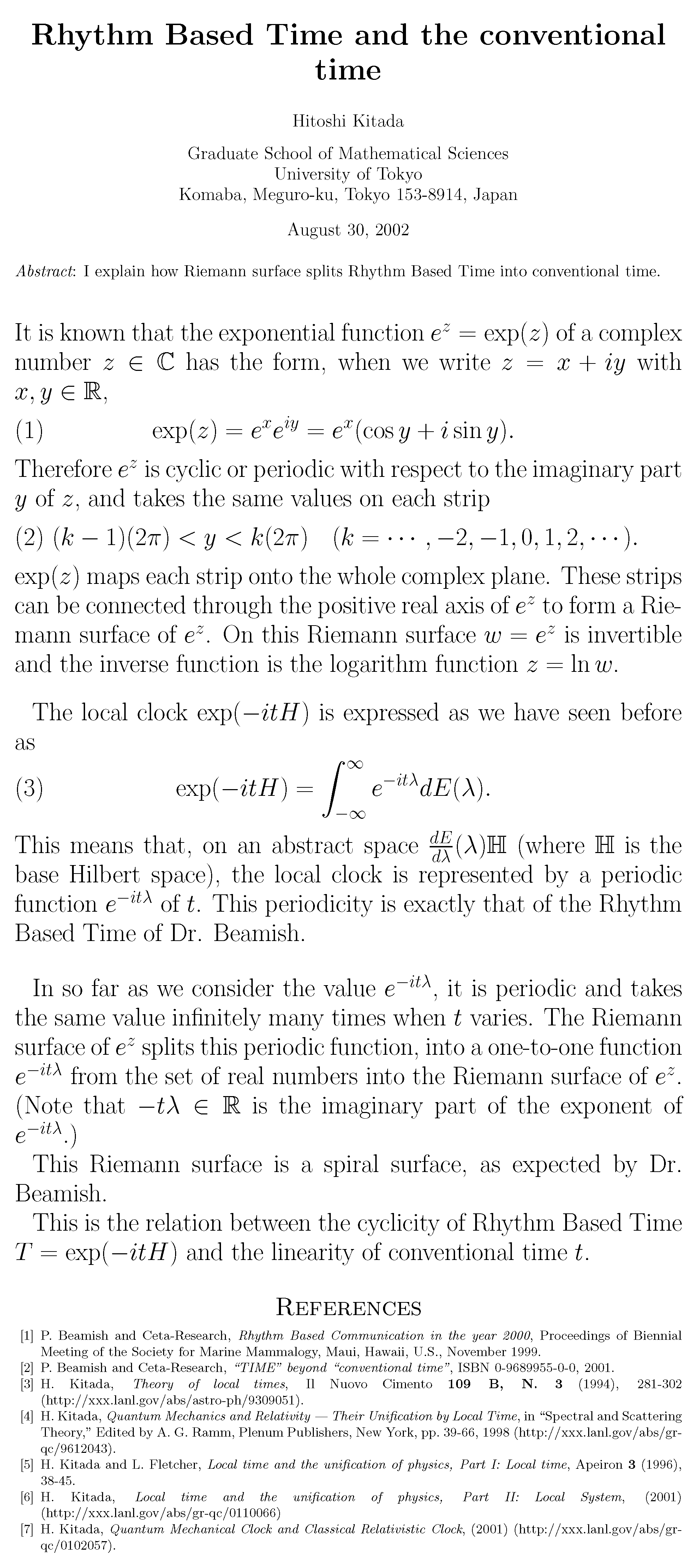Time: A New Compilation
Postscript # 112 to the "Lanzarote" paper (08/14/98)
Einstein defined time as "The reading on a clock." But he also claimed, regarding time, that there were missing elements of reality. "Supersymmetry" of new Event-Space Logic (where each of a set of variables can be rotated into one of the same set), suggests that there are exactly ten variables of which Einstein's "Clock Time" (t) would appear the central one. Three other variables, well known to physics, are the orthogonal "spacial dimensions," represented in the following diagram by Cartesian axes. The remaining six would appear to be the newly discovered "Rhythm Based Time" perception windows.
All ten variables are shown on the following diagram as:
- The "equatorial windows" - #1: "On Time," #2: "Late," #3: "Off Time," and #4: "Early,"
- the "polar windows" - #5: "North," and #6: "South," (whereby energy enters into an organism's "Event-Space Sphere"),
- the three orthogonal "spacial dimensions," (axes) as variables - #7, #8 and #9, and finally,
- variable - #10: classical, scalar, "Clock Time" (t), WHICH ALWAYS ROTATES INTO ITSELF AND NOT INTO SPACE

"NOW TIME" is related to the diameter of such an "EVENT-SPACE SPHERE." To convert the spacial diameter into a measure of "Now Time" (for example, seconds or microseconds), divide by the average velocity of the energy which creates the received sensation in any organism or machine, located at the center of the sphere (see also postscript #109, item #2).
‘FUTURE TIME', lying outside of one's "Event-Space Sphere," is comprised of mental, inscribed or machine made labels, which are invented, and which we have called "timetags."
‘PAST TIME' is similarly comprised of mental, inscribed or machine made "timetags," which may be real. BUT THESE LABELS, REAL OR INVENTED, ARE NOT TIME*. Perceived, and thus "real" time lies on or within one's "Event-Space Sphere," and includes only the 7 variables of time as given above. And thus is derived the important concept that: ALL TIME* IS "NOW TIME."


A BRIEF HISTORY OF RHYTHM BASED COMMUNICATION
1980 - 1985: Soviet scientists verbally expressed their curiosity as to how complex animals could survive in our biosphere, with so few signals.
1980 - 1990: Cetologists especially Dr. Katharine Payne, expressed their curiosity as to a meaning for Megaptera songs, involving so few signals.
1985: Soviet scientists at the Limnological Laboratories in Listvianka, were encouraged to pursue communication curiosities by Peter Beamish,.
1985 - 1990: Numerous Soviet scientists pondered a major paradigm shift.
1990: Soviet, Canadian, & U.S. scientists realized that there must exist alternate communications in Nature based on an alternate time-concept.
1992: A new form of time was simultaneously suggested, independently in Japan, Russia, and Canada, eliminating concepts of past & future.
July 1993: Bidirectional Time, named Rhythm Based Time or RBT, was demonstrated to Canadian (NL) scientists by Megaptera (humpback whales).
August 2002: Dr. Hitoshi Kitada and family visited the Canadian Cetacean Contact Laboratories in Trinity, NL & explained details of Local Time.
Rhythm Based Time has been name-changed, in publications worldwide, to:
KitadaTime, or KT, to honour Dr. Kitada's mathematical discoveries.
The use of closed words and upper case letters, as for example: OnTime, LateTime, OffTime & EarlyTime, differentiates KT from conventional time.
NAMING MAJOR CONCEPTS OF RHYTHM BASED COMMUNICATION THEORY
There exist < TWO TEMPORAL TYPES > designated: time (t), and "Time (T)."
Minds CAN ADD "Conventional time (t)" plus "Rhythmic Time (T, or 'RT')."
Minds CANNOT MULTIPLY "Conventional time (t)" by "Rhythmic Time ('RT')!"
All REAL time (t) and all REAL Time (T) = Now TIME (TIME = t+T).
One's past, and one's future consist of Temporal Scalar Labels (tags).
All Conscious Minds operate by using: Now TIME Temporal Scalar Labels.
All Conscious Minds operate by using: Mental Vector Processes, (MVPs).
MVPs are combinations of Mass/Energy Vectors & Scalar Labels (tags).
MVPs are formed at Mind's Edges & end at Mental Thought Processes.
Mind's Outer Edge borders Objective Reality with Subjective Reality.
Mind's Inner Edge borders one's Subjective Reality, with one's Memory.
All Conscious Minds Can Be Dynamic BOTH in Volume, and in Orientation.
All TIME involves A Mental Thought Process (MTP) Reading OF A Clock.
Without an object's Mental Thought Process (MTP) TIME DOESN'T EXIST!
MTPs can ANALYZE, BUT NOT GO, backwards, in Conventional MVP time.
Conventional time (t) = Curvi-linear Displacement Divided by Velocity.
Rhythmic Time (RT) = Perception Of Lateness RELATIVE To An OnTimeness.
Rhythmic Time (RT) is A Foundation Of All, Living Organism's Emotions.
Rhythm Based Communication ('RBC') is encoded in Rhythmic Time (RT).
Conventional time t has Synchronization;" RT has SynchronizaTion.
Conventional time t has Information; RT DIFFERS, as InformaTion.
Mass, Energy, Information, & InformaTion comprise All Known Phenomena.
SEVEN SYSTEM STEPS (RECIPE) TO DISCOVER RHYTHM BASED COMMUNICATION
- Animal &/or Organism Contact,
- Synchronization By Negotiation, Ensuring Mutual Low Stress (This is the 1st Communications Passkey.),
- Message Mimicry, using a Suspected Universal Greeting (This is a 2nd Communications Passkey.),
- Develop Vocabularies of Declarative Concepts by Pavlovian Conditional Responses,
- Reverse KitadaTime direction to produce equivalent Interrogative Concepts,
- Receive, & Transmit Responses as Affirmative or Negative; Altruism => <No Deceit Required>,
- Add passkeys whenever necessary for additional encryption.
Rhythm Based Communication - Communication With The Great Whales
A major question, developed worldwide during the end of the past century was: How can animals, especially cetaceans, live such seemingly complex lives, using so few signals, signs, or symbols? Was there, in actuality, another, perhaps independent communication system within Nature, that we hadn't noticed mainly because of our own principal human communications?
Such an independent communication system was demonstrated by two humpback whales under investigation by Ceta Research in Trinity, Newfoundland. It has since been found in other animals but only under low stress conditions. Under stress, organisms tend to revert to a dominant use of signals, and to Darwinian struggles for survival. But by discovering an organism with markedly reduced needs, one may usually find Rhythm Based Communication (RBC).
But How does it work?
In order to have this new type of communication, biological rhythms must be shared between two organisms so that synchronization occurs. After synchronization, Rhythm Based Communication is made possible by an organisms perception of lateness relative to on timeness. That is, the organisms, through synchronization, arrive at a common rhythm, and can then, within this synchronized rhythm, transmit and receive messages using combinations of ON-TIME, LATE, OFF-TIME and EARLY messages. Such information flow is Rhythm Based Communication (RBC).
Imagine two parallel arrows of conventional time, each associated with one of two communicating organisms, A and B. Now picture two turning wheels with their centres on the arrows of time, with different speeds of rotation (alpha rhythms).
To arrive at synchronization, organism A makes a signal in any time window of a single rotation, but only when the window reaches the vertical or NOW-axis.
Organism A then repeats this action on the next one or more complete cycles of its wheel, creating a pulsating rhythm always at the same position on its rotation (alpha concept).
The alpha concept can be confirmed by organism B, if it sends a signal which also occurs in a synchronous time window centred on the NOW-axis of any of its subsequent rotations.
This sending of a synchronous signal defines the concept of On Timeness (or zero lateness).
Now that the organisms are synchronized, they can transmit and receive messages using combinations of ON-TIME, LATE, OFF-TIME and EARLY messages.
If for a humpback whale we use 60 sec as the alpha rhythm then:
On Time (a) would be from 58 to 02 sec, centred at 12 o'clock, on a clock face.
Late (b) would then be 13-17 sec, centred at 3 o'clock.
Off Time (c) would be 28-32 sec, centred at 6 o'clock,
Early (d) would be 43-47 sec centred at 9 o'clock.
Experimentation by Ceta Research has shown that following messages now appear to be identical for some marine mammals, terrestrial mammals and seabirds.
- Synchronization: Establishing the On Time concept of a demonstrated rhythm.
- A greeting or passkey: Saying hello is done using an Off Time - Off Time - On Time message
- A reciprocal greeting: Rhythmic mimicry via a return of the hello message is a sign of lowering biological stress and readiness to communicate.
- A reciprocal overlapping greeting: This happens when #3 overlaps the timing of #2; occurring most often after repeated reciprocal greetings between the same two organisms.
- The declarative (i.e. a simple noun): Facts are stated as combinations of Late or Early, Off Time or On Time. An example from Ceta Research experiments would be Late - On Time - Late - Early to represent A Location.
- The interrogative: Questions are stated as rhythmic, time-symmetric, signals, mirror images of the declarative; an example would be Early - On Time - Early - Late to represent Location? or Are you going to Location? This is a reversal of the circular direction of RBT.
- The affirmative (Yes): A double signal On Time.
- The negative (No): A double signal Off Time.
- A farewell: A rhythmic, opposite phase message, to the greeting of #2 above. The rhythmic coding is On Time - On Time - Off Time This is commonly mimicked by the second organism during departure.
- Time Compression: A double signal in a single rotation window thereby shortening a message by one RBT revolution an example would be a greeting with a double signal Off Time followed by an On Time signal. Time compression apparently corresponds to the emotion of joy and is invariably followed by a breach for some cetaceans.
Experimentation by Ceta Research on human-animal RBC rhythms show that alpha rhythms differ by species and situation, ranging from 10 sec for young fox kits to 120 sec for fin whales.
Ceta Research believe that RBC could work for all animals (and in fact for all life). Should this be the case, then a universal greeting is feasible. A group of living organisms should be able to send and receive messages, using RBT, as if they were physically together, independent of spatial separation. Also larger vocabularies could be expected and body language should play an extensive role in communication.
It is not only important WHAT the organism does, but perhaps even more important WHEN the organism does something.
Article Source: http://EzineArticles.com/879791
Source: https://www.researchgate.net/publication/252158675
Glossary of Terms
Altruism
Having regard for others; To give without reward; To be unselfish.
Bidirectional
Functioning in two opposing spacial directions. Time T is bidirectional.
Biochemistry
The study of the chemical and physiochemical processes of living organisms.
Biophysics
The science of the application of the laws of physics to biological phenomena.
Clock
Any mechanism and/or life system that represents, or is capable of producing cyclic, recurrent, or predictable motion, and measures temporal scalar labels.
Clocking
The act of reading a clock. Either a linear or a cyclical clock.
Closed Words
Neglecting a normal space between words (e.g. OnTime). Used to signify RBT, RT, or T.
Coherent
Logical and consistent and/or having a constant phase relationship.
Communication
The passing of information, involving: a) transmission, b) reception, and c) the altering of subsequent behaviour.
CommunicaTion
As communication, excepting encoded in Rhythm Based Time RBT, RT, or T.
Comprehension
The capability of understanding.
Concept
An idea and/or general notion.
Conscious Mind
See Mind (conscious).
Continuum
Anything seen as having a continuous structure without perceptibly distinct parts.
Conventional
Traditional (in opposition to recent inventions etc.).
Conventional time t, or Ct
Traditional concepts of time as opposed to RBT, RT, or T.
Conventional timetag
Label of Conventional time t, or Ct.
Coordinate
A number that defines position by reference to a fixed figure.
Counting scalar
A scalar quantity for which the magnitude always increases, never decreases.
Cyclic
Revolving in recurrent series of events and/or phenomena.
Dimensions
a) Spacial Dimensions, which define all known geometry, or b) Variables, some of which may be scalar quantities. (OSD, three and only three).
Displacement
Distance in a direction.
Diurnal
A cycle occupying the duraTion of one Earth day.
Duration
A timetag (t) of increased quantity less one of lesser quantity.
DuraTion
A Timetag (T) of increased quantity less one of lesser quantity.
Embody
Give a concrete or discernible form.
Encode
Place into a system of concepts.
Entropy
A measure of disorganization.
Essos
Event Space Sphere Or Spheroid (pronounced 'Eee-sos'); a synonym for Conscious Mind.
Essos Edge
There are two Essos Edges, as follows: a) the spacial boundary between one's Objective Reality, and one's Subjective Reality, and b) the spacial boundary between one's memory, and one's thought systems. These two are called External and Internal Essos Edges.
Event Space Sphere
An abstract sphere useful to describe the dynamic orientation and magnitude of time t, Time T, and space variables, and containing one's Now TIME (can be HIGHLY dynamic).
Extensions
Orthagonal Spacial Dimensions, or OSDs. (OSD, three and only three).
Future
Scalar labels of Conventional time t, or Ct, or Rhythm Based Time RBT, RT, or T, and their associated mass/energies, that have not yet arrived temporally at one's Essos.
Immaterial
Without physical form or substance.
Infinity
The mathematical state of being boundless.
Information-RBC
Information encoded in Rhythm Based Time RBT, RT, or T (or InformaTion).
Information-SBC
Information encoded in sensory modalities, as in signals, signs, and symbols.
InformaTion
Information encoded in Rhythm Based Time RBT, RT, or T.
KitadaTime KT
Rhythm Based Time RBT, RT, or T inside sensory transducers.
Life
Living things and their activity.
Medar
MEmory Detection and Recovery (pronounced 'Maa-dar'). The process of Mental Vectors (MVPs) detecting and transporting memory concepts into conscious mind, into Mental Thought Processes MTPs, into Essos.
Magnitude
Size or extent (independent of spacial direction).
Mass/energy
Either mass or energy, or both.
Mental Thought Process (MTP)
A conscious mind component that receives Mental Vector Processes MVPs and subsequently may cause physical or mental actions related to them.
Mental Vector Process (MVP)
A combination of a mass/energy vector and any number of scalar quantities, formed at one's Essos Edges, and ending at one's Essos Centre.
Metaphor
The application of a description which is imaginatively but not literally applicable.
Mind (conscious)
Mass/energy and information, or informaTion, involved with the architecture of a central nervous system, and within Essos.
Mind (unconscious) and memory
Mass/energy and information, or informaTion, possibly involved with every living cell, and not within Essos.
Modalities
Prescribed methods or techniques of procedure.
Nowness
One's immediate present.
"ow time
Conventional time t, or Ct, associated with events in one's present, and contained within one's Essos.
NowTime
Rhythm Based Time RBT, RT, or T, associated with events in one's present, and contained within one's Essos.
Now TIME or NOW TIME
Both Conventional time t, or Ct, and Rhythm Based Time RBT, RT, or T, associated with events in one's present, and contained wihin one's Essos.
Objective Reality
Exterior to Essos, plus not consisting of Mental Vector Processes, MVPs and Mental Thought Processes, MTPs.
Omnipotent
Having great power.
Omnipresent
Present everywhere.
Omniscient
Having very extensive knowledge.
OnTimeness
OnTimeness is a cyclical and agreed Time Commencement Point.
Orthogonal
At right angles or 90 degrees.
OSD
Orthogonal Spacial Dimension. (OSD, three and only three).
Paradigm
A mode of viewing the world which underlies scientific theory for a period of history.
Paradigm shift
A fundamental change in approach and/or philosophy.
Past
Scalar labels of TIME and their associated mass/energy that have left one's Essos.
Perception
An interpretation based on one's understanding.
Phenomena
Facts, circumstances or occurrences that appear or are perceived.
Philosophy
Reason and argument in seeking truth and knowledge of reality.
Photon
A discrete quantity of electromagnetic energy (having both electrical and magnetic properties).
Quantum Mechanics
The mathematical form of quantum theory dealing with the interaction of particles.
RBC
Rhythm Based Communication using Information-RBC (or InformaTion).
RBT, RT, or T
Rhythm Based Time RBT, RT, or T, as opposed to Conventional time t, or Ct. A mind's perception of lateness relative to an agreed, cyclical, and synchronized, OnTimeness.
Representations
Statements made to convey opinions.
Rhythm Based Communication (RBC)
Communication encoded in RBT, RT, or T (or CommunicaTion).
Rhythm Based Information
Information encoded in RBT, RT, or T (or InformaTion).
SBC
Signal Based Communication using information-SBC.
Scalar
Having only magnitude and no spacial direction.
Semantic
Relating to meaning in language.
Senses
Bodily facilities for changing energy (transduction) from one's exterior to one's interior.
Sensitivity
The quality of being open to or affected by external stimuli.
Signal Based Communication
Communication encoded in sensory modalities as in signals, signs and symbols.
Signal Based Information
Information encoded in sensory modalities as in signals, signs and symbols.
Space
Vectors, always containing both magnitudes, and spacial directions, relating to: a) north-south, east-west, up-down, b) forward-backward, left-right, up-down, or c) north celestial pole, declination, right ascension east of The First Point of Aries, or any vector combinations thereof (a and c are objective; b is subjective).
Spacial Dimensions
Space vectors, which are most often considered orthogonal, in which case there are three and only three spacial dimensions.
Spacial Directions
Space vectors, which are not necessarily orthogonal.
Spirit
The soul.
Subjective Reality
Within Essos, and consisting of Mental Vector Processes, MVPs and Mental Thought Processes, MTPs.
Symmetric
When certain positions rotate into other positions in the same set.
Synchronization
Happening at the same Conventional time t, or Ct.
SynchronizaTion
Happening at the same Rhythm Based Time RBT, RT, or T.
Tagging
See time, Time, or TIME tagging.
time, time t, or t
Conventional time t, or Ct, linear in the direction of instantaneous mass/energy motion.
Time, Time T, or T
Rhythm Based Time RBT, RT, T. A mind's perception of lateness relative to an agreed, cyclical, and synchronized concept of OnTimeness.
TIME
Conventional time t, or Ct + Rhythm Based Time RBT, RT, or T, within Essos.
<TIME>
All combined Conventional time t, or Ct, Rhythm Based Time RBT, RT or T, TIME (t + T), as well as all temporal scalar labels (Time/timetag concepts).
time, Time, or TIME tagging
The association (either physical or mental) of Time/timetags with mass/energy vectors.
timetag vector
Conventional timetags on a mass/energy vector.
Timetag vector
Timetags on a mass/energy vector.
Timing
The arithmetic of <TIME> including the art of recording <TIME>.
t-labels
Mental, inscribed, machine made, geologic and other labels of Conventional time t, or Ct. See also timetags.
T-labels
Mental, inscribed and other labels of Rhythm Based Time RBT, RT, T. See also Timetags.
Token
A representation of an abstraction.
True altruism
To give without the expectation of a reward.
Unconscious Mind
See Mind (unconscious).
Valid
Well founded and defensible.
Variable
A quantity able to assume different numerical values.
Vector
A quantity having spacial direction as well as magnitude.

